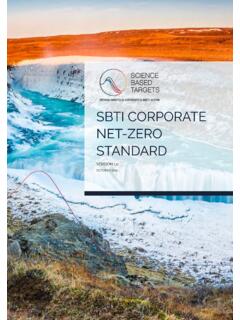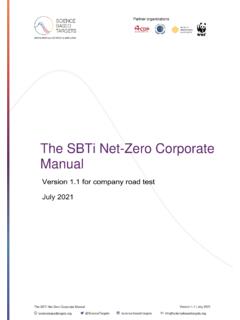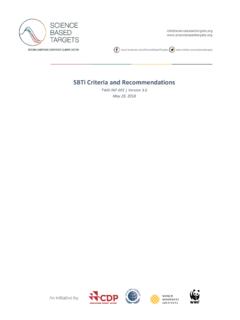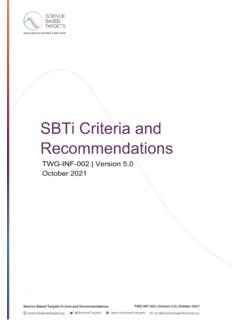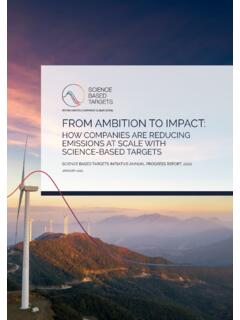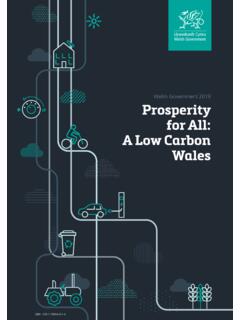Transcription of Temperature Rating Methodology - Science Based Targets
1 Open source Methodology to translate the ambition of corporate GHG. emission reductions into Temperature ratings for corporates and investment portfolios CDP Worldwide and WWF. International Version Temperature Rating Methodology A Temperature Rating method for Targets , corporates, and portfolios Temperature Rating Methodology . A Temperature Rating METHOD FOR Targets , CORPORATES, AND PORTFOLIOS. BETA VERSION. October 01, 2020. CDP Worldwide and WWF International This method is an open source framework to enable the translation of corporate GHG emission reduction Targets into Temperature scores at a target, company, and a portfolio level.
2 The method can be used to generate Temperature scores for individual Targets to translate target ambition to a common intuitive metric. The method provides a protocol to enable the aggregation of target level scores to generate a Temperature Rating for a company Based on the ambition of its Targets . Finally, the method defines a series of weighting options that can enable financial institutions and others to Built on the work of the Science Based Targets initiative, the Methodology provides a public, transparent, and Science - Based protocol to assess the ambition of corporates and portfolios Based on the ambition of Targets .
3 It enables users to assess the ambition of any public GHG. emission reduction target and can help users compare the relative ambition of one company versus another. The method may also be used to Temperature score investment portfolios and allow Financial Institutions to calculate the current Temperature score of portfolio, which is a key starting point for aligning the portfolio with long term Temperature goals such as 1. CDP Worldwide and WWF International 2020. About CDP. CDP is an international non-profit that drives companies and governments to reduce their greenhouse gas emissions, safeguard water resources and protect forests.
4 Voted number one climate research provider by investors and working with institutional investors with assets of US$106 trillion, we leverage investor and buyer power to motivate companies to disclose and manage their environmental impacts. Over 8,400 companies with over 50% of global market capitalization disclosed environmental data through CDP in 2019. This is in addition to the over 920 cities, states and regions who disclosed, making CDP's platform one of the richest sources of information globally on how companies and governments are driving environmental change. CDP is a founding member of the We Mean Business Coalition.
5 Visit or follow us @CDP to find out more. About WWF. WWF is an independent conservation organization, with over 30 million followers and a global network active in nearly 100 countries. Our mission is to stop the degradation of the planet's natural environment and to build a future in which people live in harmony with nature, by conserving the world's biological diversity, ensuring that the use of renewable natural resources is sustainable, and promoting the reduction of pollution and wasteful consumption. Find out more at 2. CDP Worldwide and WWF International 2020. Contents Methodological Overview.
6 4. 1. Target protocol .. 6. Introduction .. 6. Overview of 6. Assigning a Temperature score to disclosed Targets .. 9. Default Temperature score for companies without disclosed Targets ..14. Default score approaches ..14. Economy wide default scores ..14. 2. Company protocol ..17. Target quality criteria ..17. Target types ..17. Scope coverage ..18. Boundary coverage ..18. Target timeframe ..19. Target progress ..20. Target Using Temperature scores ..22. 3. Portfolio protocol ..23. Weighting objectives and principles ..23. Weighting Options ..24. Method Assessment ..27. Additional notes on the portfolio protocol.
7 29. 4. Method Evolution ..30. Default scoring ..30. Portfolio weighting ..30. Version References ..32. Annex 1: Target class to SR15 variable mapping ..33. Annex 2: Scenario sets used for regression models ..34. Methodological Overview Through the Science Based Targets initiative (SBTi), a large number of companies have been able to set approved Science - Based Targets since 2015. Building on the work of the SBTi, the Temperature Rating Methodology presented in this document expands the Temperature assessment of short- and medium-term corporate ambition against a wide range of end of century (2100) Temperature outcomes, between 5 C.
8 It therefore aims to translate reported corporate Targets into long-term Temperature trajectories. Assessing the ambition of corporate Targets has traditionally been very complex, as Targets can be expressed with different units, over multiple timeframes covering various types of scopes. The goal of a Temperature Rating is to translate Targets into a single common and intuitive metric that is linked to the long-term Temperature outcomes associated with the ambition of the target. The Methodology is composed of three distinct steps: Step 2 Step 3. Step 1. Company protocol: identify, Portfolio protocol: Target protocol: mapping filter and aggregate multiple aggregation of multiple target ambition levels to target scores into one company scores into one Temperature outcomes company score portfolio score The target protocol represents the first step of the process, which is to convert individual Targets of various formats into Temperature scores.
9 This is achieved by generating simple regression models for estimated warming in 2100 from climate scenarios with short, medium, and long-term trends in metrics like absolute emissions or emissions intensities. Regression models are generated Based on scenarios in the IPCC Special Report on C scenario database. In addition to defining methods for disclosed Targets , this step outlines the Methodology used to define a default score to be applied to all non-disclosing companies. Since companies have multiple climate Targets , covering different scopes and timeframes, a protocol is then used to aggregate all target data into scores at a company level (step 2).
10 This protocol defines the minimum quality criteria for determining the acceptability of a target to be scored and the steps required to identify and aggregate multiple Targets to produce an overall company score. The final step is used to weight company scores when assessing an index or portfolio of companies, such as in the context of financial portfolios. Figure 1 presents an overview of how the three protocols fit together to form the Temperature Rating Methodology . 4. CDP Worldwide and WWF International 2020. Figure 1. Temperature Rating Methodology overview 5. CDP Worldwide and WWF International 2020.


